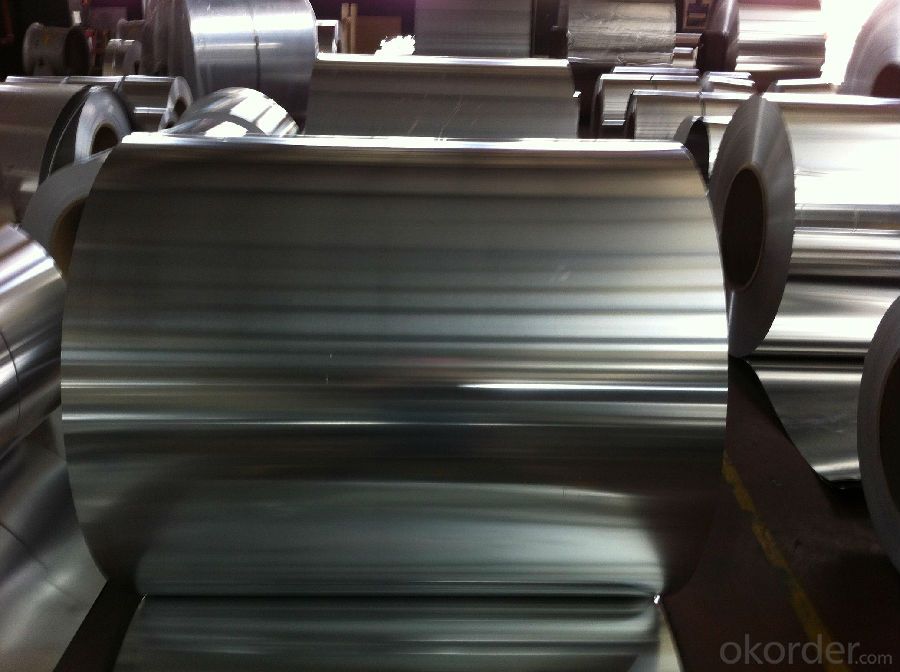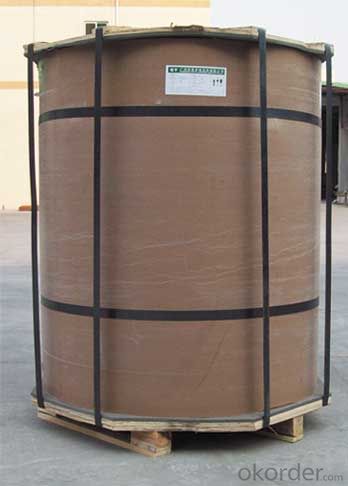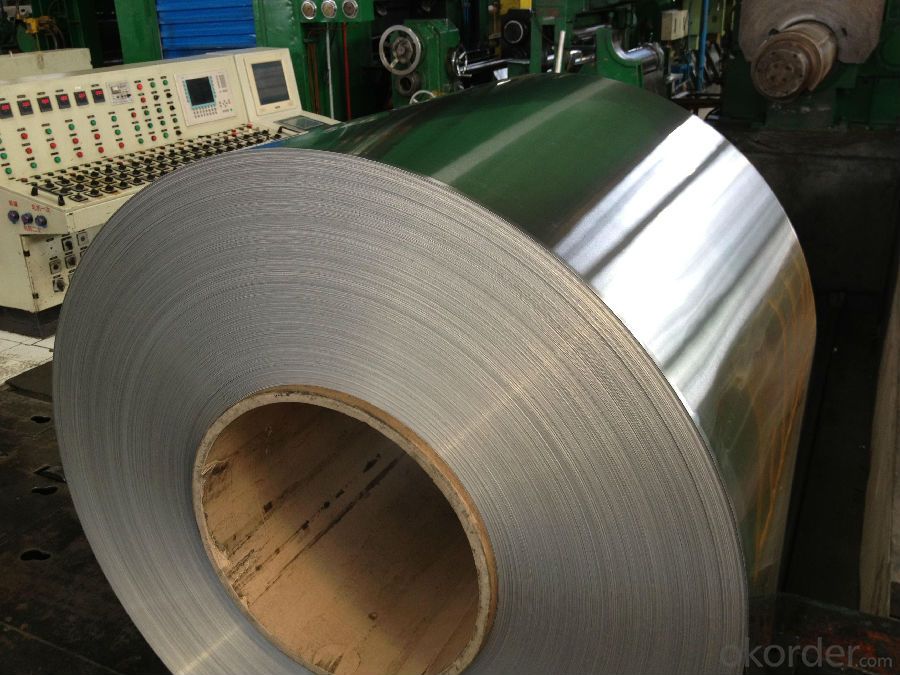Aluminium Coils for Color Coated Window Glass Decoration
- Loading Port:
- Shanghai
- Payment Terms:
- TT OR LC
- Min Order Qty:
- 2 m.t.
- Supply Capability:
- 50000 m.t./month
OKorder Service Pledge
OKorder Financial Service
You Might Also Like
Item specifice
1.Structure of Aluminium Coils for Color Coated Window Glass Decoration
Aluminium Coils for Color Coated Window Glass Decoration is one semi-finished aluminium material. The coils are widly used in the building,decoration and aluminium circle. The alloy AA3104 is one of the most common alloy in the aluminium industry. Its weight is much lower than steel. So many customers choosed aluminium material instead of steel.
2. Main features of Aluminium Coils for Color Coated Window Glass Decoration
a.Competitive price---We have our own mills and can produce mill finished aluminium coils, so we can control the production cost better.
b.Professional after-sale service---We have more than 15 years exportation experience and you need not worry about the exporation problems.
c.Fast delivery time---We can control the delivery time within 35 days.
3. Image of Aluminium Coils for Color Coated Window Glass Decoration



4. Product Specification of Aluminium Coils for Color Coated Window Glass Decoration
| Alloy | Temper | Thickness | Width | Weight |
| AA1100 | HO | 0.2MM-3MM | 1000-1500MM | Max 3 tons |
5.FAQ of Aluminium Coils for Color Coated Window Glass Decoration
What is the quality standard?
---Usually our standard is GB3880-2006
What is the largest width?
---It is 2300mm
What is the MOQ?
---Usually we can accept 80 tons.
- Q:What are the standard sizes and availability of aluminum sheets in the market?
- The sizes and availability of aluminum sheets in the market can vary depending on the location and specific requirements. Nevertheless, there are generally available sizes that can be found in most markets. In terms of thickness, aluminum sheets are commonly found in the range of 0.02 to 0.2 inches (0.5 to 5 millimeters). Thinner sheets (0.02 to 0.06 inches) are often utilized for lightweight purposes such as signage or crafts, while thicker sheets (0.1 to 0.2 inches) are typically employed for more heavy-duty applications like construction or industrial use. Regarding width and length, standard sizes of aluminum sheets are often offered in 4 feet by 8 feet (48 inches by 96 inches) or 4 feet by 12 feet (48 inches by 144 inches). These dimensions are widely available and suitable for various applications. However, it is important to note that custom sizes can also be ordered or cut from larger sheets to meet specific project requirements. Aluminum sheets can be found in various locations, including local hardware stores, metal suppliers, and online marketplaces. It is always advisable to check with local suppliers or conduct online research to determine the specific sizes and availability in your area. Additionally, different grades or alloys of aluminum may have varying availability, so it is crucial to consider the specific requirements of your project when sourcing aluminum sheets.
- Q:What are the advantages of using aluminum sheets compared to other materials?
- There are several advantages of using aluminum sheets compared to other materials. Firstly, aluminum sheets are lightweight, which makes them easy to transport and handle. This characteristic also makes them ideal for applications where weight reduction is crucial, such as in aerospace, automotive, and marine industries. Secondly, aluminum sheets have excellent corrosion resistance. They naturally form a protective oxide layer on their surface, which prevents further oxidation and corrosion. This property makes them suitable for outdoor applications, as they can withstand various weather conditions without deteriorating. Thirdly, aluminum sheets have high thermal conductivity. This means they can efficiently transfer heat, making them ideal for heat exchangers and other applications that require efficient heat dissipation. Moreover, aluminum sheets have excellent formability. They can be easily fabricated into different shapes and sizes, making them versatile for various industries. This formability also allows for complex designs and intricate details to be achieved. Furthermore, aluminum sheets have good electrical conductivity. This makes them suitable for electrical applications, such as wiring and electrical conductors. Another advantage of aluminum sheets is their recyclability. Aluminum is one of the most sustainable metals, as it can be recycled repeatedly without losing its quality or properties. This makes aluminum sheets an environmentally friendly choice. Lastly, aluminum sheets are cost-effective. Compared to other materials, aluminum is relatively affordable, making it a popular choice for many industries. In conclusion, the advantages of using aluminum sheets include their lightweight nature, excellent corrosion resistance, high thermal conductivity, good formability, electrical conductivity, recyclability, and cost-effectiveness. These properties make aluminum sheets a versatile and sustainable material for a wide range of applications.
- Q:What are the different methods of surface finishing for aluminum sheet?
- Aluminum sheets can undergo various surface finishing methods, each with its own distinct characteristics and advantages. Some commonly used methods include anodizing, painting, powder coating, polishing, and brushing. Anodizing is a widely employed technique that forms a protective oxide layer on the aluminum's surface. This process not only enhances the sheet's appearance but also improves its resistance to corrosion and durability. Anodized aluminum sheets are available in different colors and finishes, making them suitable for diverse applications. Painting is another frequently used method where a layer of paint is applied to the aluminum sheet to provide both decorative and protective coating. This approach allows for a wide range of colors and finishes, enabling customization and design versatility. Moreover, painting can enhance the sheet's resistance to weathering and scratches. Powder coating involves applying a dry, powdered coating to the aluminum sheet, which is then heated to create a durable and uniform layer. This technique offers excellent protection against corrosion, chemicals, and UV rays, making it ideal for applications requiring high durability and weather resistance. Polishing is a surface finishing method that employs abrasive materials to create a smooth and shiny surface on the aluminum sheet. This technique is commonly used to enhance the sheet's aesthetic appeal by eliminating imperfections and scratches. Polished aluminum sheets are often used in decorative applications where a reflective and lustrous surface is desired. Brushing is a process that gives the aluminum sheet a textured surface using abrasive brushes or pads. This method creates parallel lines or patterns on the sheet, resulting in a distinctive and attractive appearance. Brushed aluminum sheets find applications in architectural and interior design, as well as in the manufacturing of household appliances and automotive components. In conclusion, the various surface finishing methods for aluminum sheets offer a range of options to enhance their appearance, durability, and functionality. Whether it is anodizing, painting, powder coating, polishing, or brushing, each method brings unique benefits that can be tailored to specific applications and design requirements.
- Q:What are the different grades of aluminum sheet?
- There are several different grades of aluminum sheet available in the market, each with its own unique properties and applications. Some common grades include: 1. 1100: This grade is known for its excellent corrosion resistance and high thermal conductivity. It is often used in chemical equipment, reflectors, heat exchangers, and electrical conductors. 2. 3003: This grade is alloyed with manganese, making it highly resistant to corrosion. It is commonly used in cooking utensils, storage tanks, and architectural trim. 3. 5052: This grade has good formability and high fatigue strength. It is often used in marine applications, such as boat hulls and components, as well as in aircraft fuel tanks and structural parts. 4. 6061: This grade is known for its excellent strength-to-weight ratio and good machinability. It is commonly used in automotive parts, bicycle frames, and structural components. 5. 7075: This grade has high strength and toughness, making it suitable for aerospace applications, such as aircraft wings and fuselage structures. Each grade of aluminum sheet has its own specific characteristics and is chosen based on the requirements of the particular application. It is important to consider factors such as corrosion resistance, strength, formability, and machinability when selecting the appropriate grade.
- Q:Can aluminum sheet be used for electronic components?
- Indeed, aluminum sheet is a viable option when it comes to electronic components. This versatile material boasts numerous advantages for electronic applications. Not only is it lightweight, but it also exhibits exceptional thermal conductivity and corrosion resistance. These characteristics render it suitable for a wide range of electronic components, including heat sinks, enclosures, connectors, and printed circuit boards (PCBs). The machinability, formability, and weldability of aluminum sheets further enable efficient manufacturing processes. Moreover, aluminum proves to be a cost-effective alternative to materials like copper or steel. Nevertheless, it is crucial to acknowledge that aluminum may not be suitable for all electronic components, particularly those necessitating high electrical conductivity or magnetic shielding.
- Q:im making a presentation and once i read through it it feels like its leading up to something but then goes flat. any ideas. my project ' steel cars compared to aluminium'
- Aluminium is extremely flammable. We use it in thermite welding and as solid rocket fuel. The Emperor Napoleon carried* an aluminium fork while the lower royalty had to make do with gold forks. *In those days people carried their table wear around with them same as we carry our car keys.
- Q:Nissan A1100P aluminum plate is equivalent to what brand of domestic, where there are relevant information and instructions, mechanical design manuals or other materials manuals? Thank you.
- 1, aluminum plate A1100P equivalent to national standard AL1100 aluminum plate.2 and 1100 are pure aluminium, the content of aluminium is 99%, which can not be improved by heat treatment. With high corrosion resistance, electrical conductivity and thermal conductivity, and its small density, good plasticity, through pressure processing can produce all kinds of aluminum, but the strength is low.
- Q:is steel better for making bicycle frames.....how does it differ from the aluminum framed bikes?
- Steel is better for road bikes and touring bikes, while aluminum is better for race bikes because its lighter. Steel will rust, so if you have a bike where it rains a lot or you ride in the winter, you need to apply a coat of Frame Saver every year to keep the inside of the frame rust-free.
- Q:Using thin copper sheets and thin aluminum sheets, respectively, from heat source heat conduction to aluminum heat sink, which kind of efficiency is higher?
- Aluminum cooling fast! Copper conducts heat quickly! Is it clear enough?.Copper has a good heat conductivity. For metal conductive ability of thermal conductivity is strong.
- Q:Can 101 aluminum sheets be used in the production of decorative panels?
- Yes, 101 aluminum sheets can be used in the production of decorative panels. 101 aluminum is a commercially pure aluminum alloy known for its excellent formability and corrosion resistance. These characteristics make it suitable for various applications, including decorative panels. The aluminum sheets can be easily shaped, cut, and fabricated to create intricate designs and patterns for decorative purposes. Additionally, the corrosion resistance of 101 aluminum ensures that the panels will maintain their appearance over time, even in outdoor or high-moisture environments.
1. Manufacturer Overview |
|
|---|---|
| Location | |
| Year Established | |
| Annual Output Value | |
| Main Markets | |
| Company Certifications | |
2. Manufacturer Certificates |
|
|---|---|
| a) Certification Name | |
| Range | |
| Reference | |
| Validity Period | |
3. Manufacturer Capability |
|
|---|---|
| a)Trade Capacity | |
| Nearest Port | |
| Export Percentage | |
| No.of Employees in Trade Department | |
| Language Spoken: | |
| b)Factory Information | |
| Factory Size: | |
| No. of Production Lines | |
| Contract Manufacturing | |
| Product Price Range | |
Send your message to us
Aluminium Coils for Color Coated Window Glass Decoration
- Loading Port:
- Shanghai
- Payment Terms:
- TT OR LC
- Min Order Qty:
- 2 m.t.
- Supply Capability:
- 50000 m.t./month
OKorder Service Pledge
OKorder Financial Service
Similar products
New products
Hot products
Related keywords





























